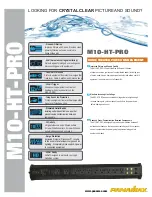
Both the primary and the secondary sides must be disconnected from the line
and the IED when plotting the excitation characteristics.
If the CT secondary circuit earth connection is removed without the current
transformer primary being de-energized, dangerous voltages may result in the
secondary CT circuits.
4.9
Checking VT circuits
M11724-2 v10
Check that the wiring is in strict accordance with the supplied connection diagram.
Correct possible errors before continuing to test the circuitry.
Test the circuitry.
•
Polarity check when applicable; this test is often omitted for CVTs
•
VT circuit voltage measurement (primary injection test)
•
Earthing check
•
Phase relationship
•
Insulation resistance check
The primary injection test verifies the VT ratio and the wiring all the way from the primary
system to the IED. Injection must be performed for each phase-to-neutral circuit.
While testing VT secondary circuit and associated secondary equipment, care
shall be exercised to isolate the VT from the circuit being tested to avoid
backcharging the VT from the secondary side.
4.10
Using the RTXP test switch
GUID-F1E29C06-7FE8-44D8-AD5A-EE8990A2AA41 v5
The RTXP test switch is designed to provide the means of safe testing of the IED. This is
achieved by the electromechanical design of the test switch and test plug handle. When the
test plug handle is inserted, it first blocks the trip and alarm circuits then it short circuits the
CT secondary circuit and opens the VT secondary circuits making the IED available for
secondary injection.
When pulled out, the test handle is mechanically stopped in half withdrawn position. In this
position, the current and voltage enter the protection, but the alarm and trip circuits are still
isolated and the IED is in test mode. Before removing the test handle, check the measured
values in the IED.
Not until the test handle is completely removed, the trip and alarm circuits are restored for
operation.
1MRK 502 067-UEN B
Section 4
Starting up
47
Commissioning manual








































